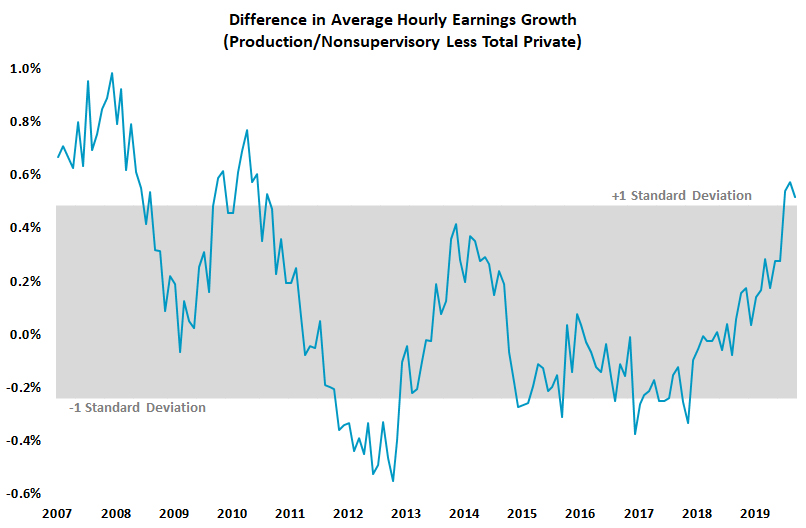Joe Zidle: The Winds of Change
My first job was at the age of 12, cleaning greasy vent hoods and grimy fryolators for a family-owned restaurant in my small New Hampshire town. It was 1984, and I earned $2.55 per hour. Four years later, I earned the biggest pay increase in my life when I joined the phone company and made more than $20 an hour. Overtime and holiday pay were two-and-a-half to three times my base pay. Had I stayed, I could have been retired with a defined benefit plan right now. Alas, the road not taken. But the road I did take requires me to spotlight important trends in hourly wage data—like what last month’s jobs report showed.
Help wanted, desperately Hourly wage data in November’s jobs report showed that pay for the rank-and-file workers who fuel our economy is increasing at its fastest rate in over a decade. The last time that production and nonsupervisory workers had 3.7% year-over-year gains in average hourly earnings (AHE) was 2008. Even more interesting is the difference in earnings growth between higher-paid supervisory employees and nonsupervisory employees: it’s the widest in a decade. Clearly, the real labor market tightness is skewed towards the lower-earning jobs. In my view, pay gains for the average hourly worker will accelerate even further in 2020.
Widest Spread Between Wage Growth Rates in a Decade(1)

The law of averages, and a better measure The broadest measure of employment wage gains, AHE for total private employees, shows gains to be in the low-3% range. But that might not be quite right. A recent white paper from the Dallas Federal Reserve highlighted that a structural flaw in the formula might skew the overall average downward. Essentially, the AHE gives more weight to higher-paid workers. And pay increases for these workers, while larger in absolute terms, are smaller as a percent of their total compensation. An alternative study by the Dallas Fed, which focused on the life-cycle wage growth of individual workers, found that wage growth for the average individual is significantly higher than the Bureau of Labor Statistics data. Blackstone’s own internal pay data for portfolio company hourly employees also point to faster growth than government data.
Effective minimum wages: the gift set to keep on giving Hourly, lower-paid workers will get another boost in 2020. Many state and local municipalities enacted minimum wage laws that vastly exceed the federal minimum. The so-called effective minimum wage increased 8.2% in 2019, the fastest annual growth since the late 1990s.(2) Next year, the effective minimum wage is set to increase by about 6.6%, with most increases kicking in on January 1st.(3) Many workers who do not make the minimum wage are within an income band or two of it, and all will benefit from the rising tide.
Winds of inflation Wage strength is a special relief, but it brings risks. Inflation pressures are likely to emerge as hourly earnings push higher. Other sources of inflation are in the air as well. For one, I believe that further home price appreciation is likely. Also, medical service costs started to increase recently. My view is that expectations for inflation are too low. In 2020, look for these expectations to change.
(1) Bureau of Labor Statistics and Blackstone Investment Strategy, as of 11/30/19.
(2) Evercore ISI, as of 4/15/19.
(3) Blackstone Investment Strategy calculations and Evercore ISI, as of 12/6/19.
The views expressed in this commentary are the personal views of the author and do not necessarily reflect the views of The Blackstone Group Inc. (together with its affiliates, “Blackstone”). The views expressed reflect the current views of the author as of the date hereof and Blackstone undertakes no responsibility to advise you of any changes in the views expressed herein. For more information about how Blackstone collects, uses, stores and processes your personal information, please see our Privacy Policy here: http://go.pardot.com/e/213192/privacy/68f9x/182811975?h=L3PDlTnbE2h0R6yw-jpiXWquHwiOdKAOzy99H3DK9f8.
Blackstone and others associated with it may have positions in and effect transactions in securities of companies mentioned or indirectly referenced in this commentary and may also perform or seek to perform services for those companies. Investment concepts mentioned in this commentary may be unsuitable for investors depending on their specific investment objectives and financial position.
Tax considerations, margin requirements, commissions and other transaction costs may significantly affect the economic consequences of any transaction concepts referenced in this commentary and should be reviewed carefully with one’s investment and tax advisors. All information in this commentary is believed to be reliable as of the date on which this commentary was issued, and has been obtained from public sources believed to be reliable. No representation or warranty, either express or implied, is provided in relation to the accuracy or completeness of the information contained herein.
This commentary does not constitute an offer to sell any securities or the solicitation of an offer to purchase any securities. This commentary discusses broad market, industry or sector trends, or other general economic, market or political conditions and has not been provided in a fiduciary capacity under ERISA and should not be construed as research, investment advice, or any investment recommendation. Past performance is not necessarily indicative of future results.



